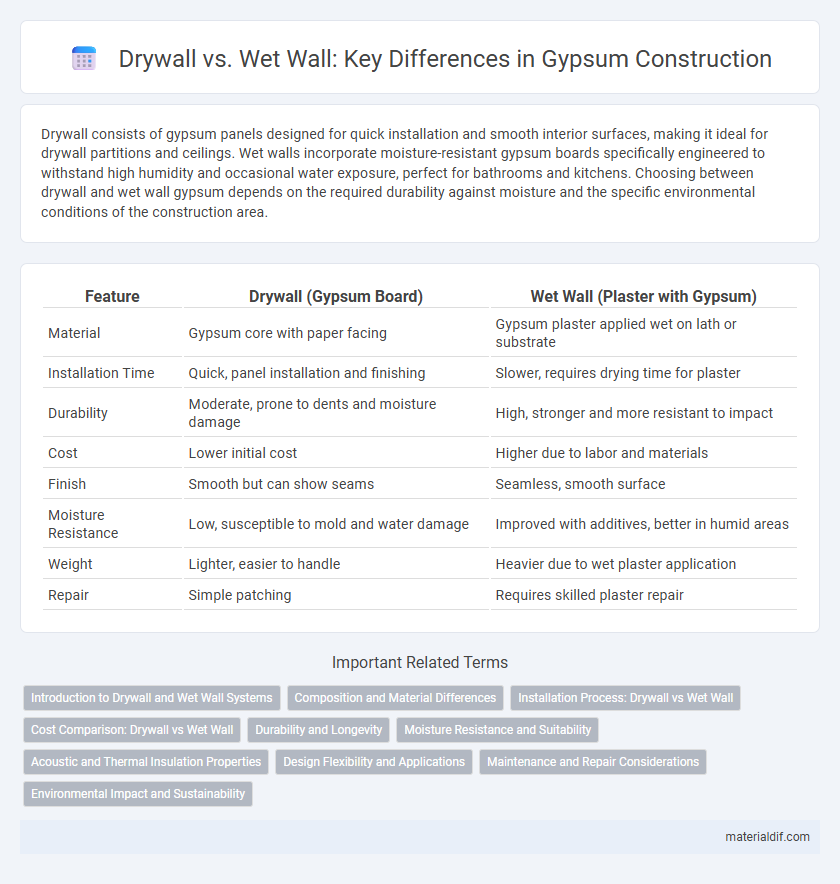Drywall consists of gypsum panels designed for quick installation and smooth interior surfaces, making it ideal for drywall partitions and ceilings. Wet walls incorporate moisture-resistant gypsum boards specifically engineered to withstand high humidity and occasional water exposure, perfect for bathrooms and kitchens. Choosing between drywall and wet wall gypsum depends on the required durability against moisture and the specific environmental conditions of the construction area.
Table of Comparison
| Feature | Drywall (Gypsum Board) | Wet Wall (Plaster with Gypsum) |
|---|---|---|
| Material | Gypsum core with paper facing | Gypsum plaster applied wet on lath or substrate |
| Installation Time | Quick, panel installation and finishing | Slower, requires drying time for plaster |
| Durability | Moderate, prone to dents and moisture damage | High, stronger and more resistant to impact |
| Cost | Lower initial cost | Higher due to labor and materials |
| Finish | Smooth but can show seams | Seamless, smooth surface |
| Moisture Resistance | Low, susceptible to mold and water damage | Improved with additives, better in humid areas |
| Weight | Lighter, easier to handle | Heavier due to wet plaster application |
| Repair | Simple patching | Requires skilled plaster repair |
Introduction to Drywall and Wet Wall Systems
Drywall, composed of gypsum plaster sandwiched between paper layers, forms a primary material in interior wall construction, offering ease of installation and fire resistance. Wet wall systems integrate plumbing and electrical components within a gypsum-based enclosure, facilitating moisture management through specialized water-resistant gypsum boards. Both systems rely on gypsum's versatility but cater to distinct functional requirements in building interiors.
Composition and Material Differences
Drywall is primarily composed of gypsum plaster sandwiched between two thick sheets of paper, offering a lightweight and easy-to-install wall solution. Wet walls, in contrast, incorporate materials like cement board or moisture-resistant gypsum combined with waterproof membranes, designed to withstand high humidity and moisture exposure. The distinct composition influences durability, with drywall being less suitable for wet environments compared to the more resilient wet wall assemblies.
Installation Process: Drywall vs Wet Wall
The installation process for drywall involves attaching gypsum panels to a metal or wood frame using screws or nails, followed by taping, mudding, and sanding to create a smooth surface. Wet wall installation requires applying multiple layers of gypsum plaster directly onto a masonry or brick surface, which demands careful mixing, troweling, and drying time between coats. Drywall offers quicker installation and easier repairs, while wet wall provides superior durability and moisture resistance in specific environments.
Cost Comparison: Drywall vs Wet Wall
Drywall installation generally costs between $1.50 to $3.50 per square foot, making it a more budget-friendly option compared to wet walls, which can range from $4 to $8 per square foot due to the additional materials and labor required for waterproofing and moisture resistance. Wet walls, often used in bathrooms and kitchens, involve gypsum boards treated for water resistance or cement boards, increasing both material and installation expenses. Choosing drywall typically reduces upfront costs, but wet walls offer long-term durability against moisture that may justify their higher price in moisture-prone environments.
Durability and Longevity
Drywall made from gypsum boards offers moderate durability but is susceptible to water damage and mold growth, reducing its longevity in moist environments. Wet walls, typically constructed with cement-based materials and waterproof membranes, provide superior resistance to moisture, enhancing their durability and lifespan in bathrooms and kitchens. Choosing wet wall systems ensures better performance in damp areas, minimizing maintenance and replacement costs over time.
Moisture Resistance and Suitability
Drywall made from gypsum offers moderate moisture resistance, suitable for interior spaces with low humidity, while wet walls--constructed using cement boards or specialized moisture-resistant gypsum boards--provide superior protection against water exposure. Moisture-resistant drywall products, such as green board or purple board, enhance durability in bathrooms and kitchens but still require careful sealing to prevent mold. Wet walls are ideal for high-moisture environments like showers and basements, ensuring long-term structural integrity and minimizing damage from damp conditions.
Acoustic and Thermal Insulation Properties
Drywall composed of gypsum boards offers moderate acoustic insulation by dampening sound transmission through its dense, layered structure, making it suitable for interior walls requiring sound control. Wet walls, typically constructed with wet plaster applied over masonry or lath, provide superior thermal mass and enhanced soundproofing due to the material's thickness and density, effectively moderating temperature fluctuations and reducing noise infiltration. Both systems benefit from gypsum's inherent fire resistance and moisture regulation, but wet walls excel in environments demanding higher acoustic and thermal performance.
Design Flexibility and Applications
Drywall composed of gypsum boards offers exceptional design flexibility, allowing easy cutting, shaping, and installation for various interior wall applications such as partitions, ceilings, and decorative features. Wet walls, incorporating gypsum-based plaster applied in multiple layers, provide a smooth, durable surface ideal for curved or intricate architectural designs and superior moisture resistance in bathrooms or kitchens. Both systems leverage gypsum's versatility but differ in suitability depending on project requirements for speed, finish quality, and environmental resilience.
Maintenance and Repair Considerations
Drywall, composed primarily of gypsum gypsum board, offers easier maintenance and repair since its surface is smooth and uniform, allowing for simple patching and sanding to fix dents or holes. Wet walls, often incorporating cement and plaster materials with gypsum layers, demand more extensive repair processes due to susceptibility to moisture damage and cracking, requiring specialized waterproofing and plaster restoration techniques. Choosing drywall minimizes long-term repair costs and effort, especially in environments prone to minor impacts and wear.
Environmental Impact and Sustainability
Drywall made from gypsum offers a more sustainable option compared to wet walls due to its low energy consumption during production and high recyclability. Wet walls often rely on materials that require intensive resource use and generate more construction waste. Gypsum drywall's ability to be recycled reduces landfill contributions, enhancing its environmental friendliness in sustainable building practices.
Drywall vs Wet wall Infographic

 materialdif.com
materialdif.com